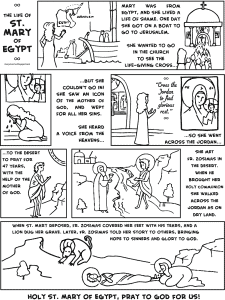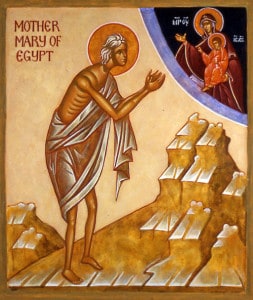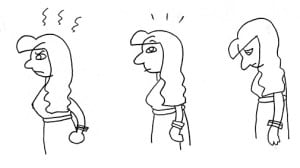Guest post by Grace Brooks
When I set out to write my book for young readers called Queen Abigail the Wise, I knew that it was going to begin on the first Sunday of Lent and end on Pascha night. So naturally, it would include the fifth Sunday in Lent — the Sunday of St. Mary of Egypt, which we celebrate this year on April 17 — and I was pretty excited about that. St. Mary is my patron saint, and like a lot of my “Mary-sisters,” I tend to bring up her name and her story whenever possible. (If by any chance, you don’t know her story, HERE’s a great brief version that Frederica Mathewes-Green passed along.)
But when I actually got to that part of the book, I had the curious experience of finding myself shy to present her life story fully and completely. It wasn’t necessary for my plot that all the details be known — the full hagiography as it was passed down in the 7th century is pages and pages long– but I was actually so sketchy about St. Mary’s story that my editor (who isn’t Orthodox) called me on it. She said that she couldn’t really figure things out at that point, and she encouraged me to go back and be more specific.
Censoring St. Mary?

Parents may like to print out this page for young children. It came from the blog Many Mercies and covers St. Mary’s story.
Easier said than done, right? St. Mary herself describes her early life with words like “vile,” “disgraceful,” “shameless,” and tells Zosima that when she tells him how she used to act, he will be bound to run from her “as from a snake.” But — to speak plainly — what is it that we’re talking about? Obviously there’s the fact that Mary, by her own admission, was such a slave to her carnal passions that she would sleep with anyone, and not just to earn a living as a prostitute.
Really though, that isn’t that hard to gloss over, if you’re telling the story to young ears. (And by the way, the link above on Frederica’s website has been delicately doctored in that way, so it’s safe for all ages to read.)
But that really wasn’t the biggest deal, it seemed to me. What made Mary’s life story sound so shocking is that she said it was so shocking. She was unwavering and honest about the depths of her depravity, and even after 47 years of repentance, she was still alive to shame. We’re so used to something far removed from that these days. Partly because of the sliding morality scale of the world around us, and partly just because nobody likes feeling guilty, we’re much more likely to think that our behavior only affects us, that it’s no big deal. We hear a lot of expressions like “we’re only human,” “don’t sweat it,” or “get over it.”
 Does that mean St. Mary had it wrong? I think it just means that the times have changed, and not totally for the better. That’s certainly not to say, though, that her level of humility and contrition is something that most of us could pull off, or should ever attempt. But one woman, at one time, did it, and that sets a kind of golden standard. Shining out from the fifth week of Lent — almost at the end — there’s one example of what a human being is capable of, when the light of Christ shines forth.
Does that mean St. Mary had it wrong? I think it just means that the times have changed, and not totally for the better. That’s certainly not to say, though, that her level of humility and contrition is something that most of us could pull off, or should ever attempt. But one woman, at one time, did it, and that sets a kind of golden standard. Shining out from the fifth week of Lent — almost at the end — there’s one example of what a human being is capable of, when the light of Christ shines forth.
I would be happy to just tell others what a saint Mary is, what an inspiration. But I think that in order to tell the story correctly, you have to begin with the scandalous part — that a woman who had sinned so greatly didn’t hold back in telling her story, so that Zosima would understand the fullness of the forgiveness she was granted. That, too, is the inspiration she brings us. With only a few weeks to go, that is the beginning of the light of Pascha, and we can thank Mother Mary of Egypt for its intensity this week.
The icon of St. Mary of Egypt is by the hand of iconographer Heather MacKean. You can see more of Heather’s work, including individual icons, churches, and workshops, at her website.
Read More
17 essential picture books for Orthodox Christian kids: If you’re looking for picture books that include stories about Orthodox Christian people and traditions, you’ll find them on this list.
Disabilities and Special Needs in the Church: Some people are uncomfortable around people with disabilities. They don’t know what to do or say. You can get some advice here, from people with disabilities, to make it easier.
Justinian and Theodora: A Love Story: St. Theodora, the wife and co-ruler with St. Justinian the Great, is one of my very favorite saints.
Buy the Book: Catherine’s Pascha
FINALIST IN THE 2015 USA BEST BOOK AWARDS
Catherine doesn’t like vegetables. She doesn’t like naps. She doesn’t like it when her mom combs her hair. She loves hot dogs, chocolate cake, and her best friend, Elizabeth. Most of all, she loves Pascha! Pascha, the Orthodox Christian Easter, is celebrated in the middle of the night, with processions and candles and bells and singing. And Catherine insists that she’s not a bit sleepy.
Celebrate the joy of Pascha through the magic of a book: Catherine’s Pascha. Available on Amazon, Bookshop.org, and my webstore.




